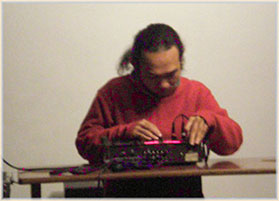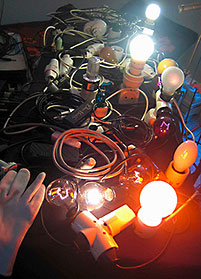21. November 2008 Freitag – 20 h
mex im Künstlerhaus Dortmund
FLICKR
KURZFILMPROGRAMM
LEE KWANG GOH

—————————
FLICKR
MICHAEL VORFELD [D]
ULI BOETTCHER [D]
Glühlampen und Elektronik
KURZFILMPROGRAMM
TOMATO ONE/NAVIGATOR
Regie: Sami van Ingen [FIN]
2006 / 5 MIN
Musik: Petri Kuljuntausta [FIN]
———
LE TRAIN OÙ VONT LES CHOSES
Regie: Nathalie Bujold [CDN]
2005 / 8:23 MIN
Musik: Gerard Leckey und Lary Seven [CDN/USA]
———
LIGHT FIELD II
Regie: Richard Garet [USA]
2008 / 14:33 MIN
Musik: Wolfgang R. von Stürmer [USA/D]
LEE KWANG GOH [MAL]
stereo DJ mixer
———
Wenn Glühlampenseelen flimmern und flackern, bleibt kein Ohr unberührt. Michael Vorfeld entwirft mit dem Gebrauch verschiedener Glühbirnen ein visuell komplexes Geflecht, das sich mittels Tonabnehmer, Mikros und elektrischen Schaltelementen klanglich veräußert. Das perkussive An und Aus und die gepflegte Dimmerei wird von Uli Boettcher aufgenommen, der mit seinem selbstgebauten, schnell reagierenden Setup den physikalischen Input seines Flickr-Partners mixt und transformiert, was das Ganze zu einem impulsanten Klang-Licht-Spiel komplettiert. Electric-trick&electronic-sonic, Catweazle würde staunen.
Die modernen Errungenschaften Licht, Zug und Flugzeug sind die Protagonisten der drei Highlights des New Yorker Programms screen compositions (kuratiert von Katherine Liberovskaya/Montreal). Die Kooperationen von Filmemachern und Musikern zeigen abstrakte Ausschnitte zeitgenössischer Wirklichkeit und umkreisen mit schnellen Schnitten und Bildabfolgen den schillernden Begriff des Impressionismus. Schnitt.
Ein DJ-Stereomischpult ist alles, was Lee Kwang Goh aus Malaysia benötigt, um live faszinierende Klanglandschaften wie aus dem Nichts zu zaubern. Scheinbar von konzeptioneller Kunst beeinflusst, verkabelt er den Ausgang einer der Spuren mit dem Eingang einer anderen Spur – der Mixer als Werkzeug der Selbstreferentialität. Das klingt theoretisch trocken, aber in Realo nach Good Vibrations mit dröhnenden und glucksenden Feedbacks; natürlich artifiziell.
———
mehr // more Michael Vorfeld: www.vorfeld.org
mehr // more Goh Lee Kwang: www.geocities.com
———
Flickr
– Michael Vorfeld (D)
– Uli Boettcher (D)
light bulbs and electronic
short film program
– „Tomato One / Navigator“, Sami van Ingen (FIN), 2006, music: Petri Kuljuntausta (FIN)
– „Le train où vont les choses“, Nathalie Bujold (CDN), 2005, music: Gerard Leckey + Lary Seven (CDN/USA)
– „Light Field II“, Richard Garet (USA), 2008, music: Wolfgang R. von Stürmer (USA/D)
Lee Kwang Goh (MAL)
stereo DJ mixer
No ear remains unaffected, when souls of light bulbs flicker and glimmer. Michael Vorfeld sketches a visually complex network with the use of different bulbs, which realizes itself sonically by means of pick-ups, micros and electronic control elements. The percussive on and off and the cultivated dimmering is taken up by Uli Boettcher, who mixes and transforms the physical input of his Flickr-partner with his self-built, fast reacting setup. This activity completes the whole into an impulsive sound-light-play. Electric trick & electronics sonic, Catweazle would be astonished.
The modern achievements light, plane and airplane are the protagonists of three highlights of the New Yorker program screen compositions (curated by Katherine Liberovskaya/Montreal). These co-operations of film producers and musicians display abstract extracts of contemporary reality and circuit with fast cuts and sequences the dazzling term Impressionism. Cut.
A DJ stereo mixer is all, what Lee Kwang Goh from Malaysia needs to perform live magic fascinating sound landscapes out of nothing. Apparently affected by conceptual art, he wires the output of one of the tracks up with the input of another track – the mixer as a tool of self-referentiality. That sounds theoretically dry, but in reality like Good Vibrations with hums and chortle feedbacks; naturally artificial.
———
——— ——————
Veranstaltet von mex – intermediale und experimentelle Musikprojekte e.V. Mit freundlicher Unterstützung durch das Künstlerhaus Dortmund sowie Pro Jazz e.V. und dem Kulturbüro der Stadt Dortmund.
